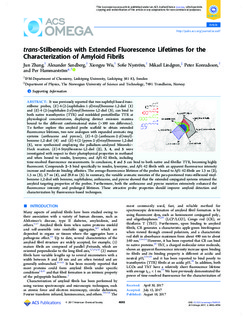trans-Stilbenoids with Extended Fluorescence Lifetimes for the Characterization of Amyloid Fibrils
Zhang, Jun; Sandberg, Alexander; Wu, Xiongyu; Nyström, Sofie; Lindgren, Mikael; Konradsson, Peter; Hammarström, Per
Journal article, Peer reviewed
Published version
Permanent lenke
http://hdl.handle.net/11250/2500800Utgivelsesdato
2017Metadata
Vis full innførselSamlinger
- Institutt for fysikk [2695]
- Publikasjoner fra CRIStin - NTNU [38127]
Sammendrag
It was previously reported that two naphthyl-based trans-stilbene probes, (E)-4-(2-(naphthalen-1-yl)vinyl)benzene-1,2-diol (1) and (E)-4-(2-(naphthalen-2-yl)vinyl)benzene-1,2-diol (3), can bind to both native transthyretin (TTR) and misfolded protofibrillar TTR at physiological concentrations, displaying distinct emission maxima bound to the different conformational states (>100 nm difference). To further explore this amyloid probe scaffold to obtain extended fluorescence lifetimes, two new analogues with expanded aromatic ring systems (anthracene and pyrene), (E)-4-(2-(anthracen-2-yl)vinyl)benzene-1,2-diol (4) and (E)-4-(2-(pyren-2-yl)vinyl)benzene-1,2-diol (5), were synthesized employing the palladium-catalyzed Mizoroki–Heck reaction. (E)-4-Styrylbenzene-1,2-diol (2), 3, 4, and 5 were investigated with respect to their photophysical properties in methanol and when bound to insulin, lysozyme, and Aβ1-42 fibrils, including time-resolved fluorescence measurements. In conclusion, 4 and 5 can bind to both native and fibrillar TTR, becoming highly fluorescent. Compounds 2–5 bind specifically to insulin, lysozyme, and Aβ1-42 fibrils with an apparent fluorescence intensity increase and moderate binding affinities. The average fluorescence lifetimes of the probes bound to Aβ1-42 fibrils are 1.3 ns (2), 1.5 ns (3), 5.7 ns (4), and 29.8 ns (5). In summary, the variable aromatic moieties of the para-positioned trans-stilbenoid vinyl-benzene-1,2-diol with benzene, naphthalene, anthracene, and pyrene showed that the extended conjugated systems retained the amyloid targeting properties of the probes. Furthermore, both the anthracene and pyrene moieties extensively enhanced the fluorescence intensity and prolonged lifetimes. These attractive probe properties should improve amyloid detection and characterization by fluorescence-based techniques.
